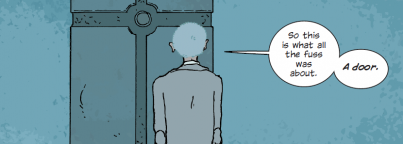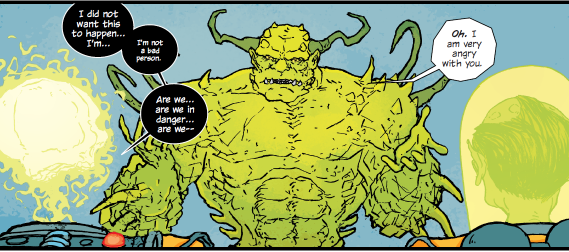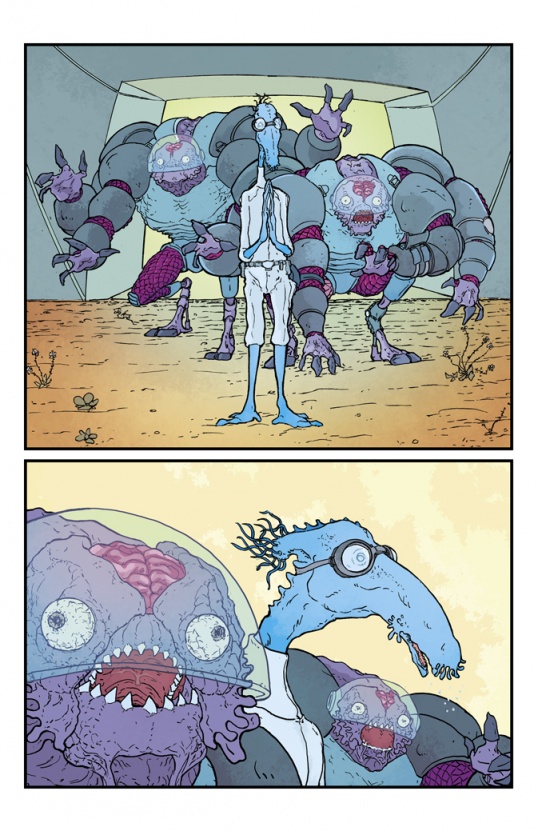
Welcome to The Multiversity Projections, our monthly column focused on the Image Comics series “The Manhattan Projects” from Jonathan Hickman and Nick Pitarra. Each month, we’ll be taking a look at the most current issue of the series and comparing notes from actual history and the alternate version presented in the book, and trying to use actual historical data to predict where the series is going next. This is a spoiler-heavy column, so if you have not yet read the most current issue of “The Manhattan Projects”, be warned that many major plot points will be discussed.
The column logo is designed by the incredible Tim Daniel, whose work can be found here.
Disclaimer: I am not an expert in either science or World War II history; all of the information I will be using in this column is either easily found on the internet or is purely my opinion.
This month, writer Jonathan Hickman and artist Nick Pitarra join us to discuss the more cosmic revelations found herein.
If you’ve been granted security clearance, read on for your briefing.

This month, “Horizon” looks to the skies, into Feynman’s past, and into a future of destruction.


The only character that has been a presence for a few issues, without real explanation of who he is, is Doctor Weiss. Early on, I tried to find any records of “red-haired scientists from the Manhattan Project” before I knew his name, and that search was almost as fruitless as my search for a “Weiss from the Manhattan Project.” All I’ve found is this interesting, sad post on a message board on the “Atomic Heritage Foundation” website.
While I doubt that this is where writer Jonathan Hickman got the name Weiss, I thought I would share:

“What I learned was the difference between value and cost. Every decision that followed was simply a product of weighing the potential punishment.”
Feynman distinguishes here between what something is worth (value), versus what you must give up to get it (cost). So Feynman, through his father’s beatings, learns that certain things aren’t going to go unpunished in his home, so are those things worth doing? Is a choice between the belt and the stick worth whatever indiscretions he may commit?
See “5 Projections” for more on this.

We are provided with a map (partially included above, with some parts lost due to the piss-poor cropping skills of yours truly) of the various sectors of the Milky Way, and what creatures/planets reside there. So far, besides for Earth, we have encountered, or at least heard about, the Raal, the Siill Empire, and the Auolo-Daa Federation.

The gateway, the door, whatever we have been calling it, is identified by aliens as being a “Pulling Way.” Presumably, this device is able to pull other worlds to Earth (or wherever it is located), in order for extraterrestrial communication/negotiation/obliteration.
What is unknown is how precise the Pulling Way is; for instance, the Daghlian/Fermi/Weiss party manages to get exactly where they are going, but why did Einstein wind up pulling an evil world towards ours last issue?
Continued below
In an issue of many quotes, this one by Raal may be the most important one. How do we measure progress? Scientifically, these Projects have been extraordinarily successful. But morally, they have been deadly. Genocide, irradiation , vaporization, cannibalism and more have all reared their ugly faces already because of these experiments and their scientific fathers. Can you call it a successful family vacation if half your family doesn’t make it back alive but the half that do wind up wealthy and successful?
In an interivew, Oppenheimer was asked how he felt directly after the Trinity explosion, and he said:
We knew the world would not be the same. Few people laughed, few people cried, most people were silent. I remembered the line from the Hindu scripture, the Bhagavad-Gita. Vishnu is trying to persuade the Prince that he should do his duty and to impress him takes on his multi-armed form and says, “Now I am become Death, the destroyer of worlds.” I suppose we all thought that, one way or another.
This quote is adapted slightly in the final page of this issue, with Oppenheimer, standing in front of his many personalities, as saying “We have become death, the destroyer of worlds.” This is a chilling quote, as Oppenheimer in real life was, seemingly, saying this in a mournful way, whereas Oppenheimer in this issue is reveling in being the destroyer of worlds.
Oppenheimer asked “Hmmm?” earlier this issue, and here it is answered: “Hmmm!”

1. Raal — With last issue’s foray into intergalactic travel, the scope of the series has been busted wide open, and what was once an Earth-based science book is quickly becoming a universe-based science book. And with Raal, we have a character of both great power and with suspicions about Earth. This is the first real antagonist the book has presented. As I posited a few months ago, science is the protagonist of this book, and so Raal, despite being a threat to the scientists, isn’t a real threat to science, only Earth-based science. So is he a villain? I guess so, but I can’t say definitively.
What I will guess, though, is that Raal is going to be a looming threat over the proceedings for some time to come, and will act, perhaps, to curtail the out of control violence the scientists are capable of, and prone to, so far in the series.

2. The Stick V. the Belt — In the flashback we get to Feynman’s childhood, Richard is asked if he would prefer a beating from “the stick or the belt” from his father. Later, through narration, we learn that Feynman always preferred the stick.
A stick would appear to be a blunter type of beating, one that would hurt like hell when struck with it. The belt would hurt, too, but in a less blunt force type of way, and the welts a belt would leave would linger and hurt for longer than the stick.
This also relates back to the second quote from Clavis Aurea this issue; value and cost, and weighing the potential punishment. The stick is going to be a traumatic, painful punishment, but one that you could put behind you (no pun intended) relatively easily. The belt is going to throb for longer and make you wish you chose the stick.
Relating this back to the series, Feynman seems to be a bold man, one who makes decisions that might upset people and feel little remorse about it. The stick is his method of living life — he goes in, does something audacious, and deals with the immediate repercussions. Oppenheimer seems more the belt; everything he does is a slow burn, and his effects linger far longer and sting far worse than Feynman’s.
This imagery is also very close to a lyric from “Wind Up” by the Foo Fighters: “I have a choice between the bat and the belt/each time I hear about the hand you’ve been dealt.” I think this probably isn’t intentional, but anytime I can reference The Colour and the Shape, I try and do so. 90’s!
Continued below3. Red and Blue — I don’t often see too many parallels between “The Manhattan Projects” and many other non-Hickman penned comics. But the stark blue and red coloring in flashback issues has been following a pretty clear pattern very close to a very popular DC comic, so while I don’t believe this to be intentional, I want to have some fun with this.
In all the flashbacks, blue represents hope: young Feynman, Albert Einstein, Robert Oppenheimer. Similarly, red represents opposition to that hope: Feynman’s dad, Albrecht Einstein, Joseph Oppenheimer, the Bible, the stick and the belt.

Well, in Green Lantern stories, blue is the light of hope, and the blue ring wielders help restore people and bring hope to the universe. Red is the light of rage, and the wielders of the red rings spew venom and act impulsively.
This lines up pretty nicely; blue Albert, trying to improve the world, is slaughtered by red Albrecht, blue Robert is killed and consumed by Joseph, Feynman’s father doesn’t believe in the goodness of man and instead wants to beat his son into something great.
The colors appear throughout the “current” times too, but are used very specifically and sparingly. Oppenheimer wears a blue suit, but the red bowtie betrays the color of his outerwear. The aliens, imperfect strangers who want to share knowledge with us, are destroyed by a red-haired Weiss. The other civilizations in the Milky Way are all presented as shades of red, with Earth alone being blue.
That last one is particularly interesting, as Earth has done nothing but destroy and, essentially, fuck up the universe; but remember who made the map: men. We see our rage as hope, and interpret the hopeful nature of others as rage.
And the worst part of all is that the rage always seems to win.

4. Genius versus Luck – One of the interesting piece of the book thus far has been that, with just a few notable exceptions, all of the characters are geniuses (or, at least, “highly intelligent,” like Albrecht Einstein). The two characters without such designation are General Groves and President Truman. These two characters, either by their own admission, or just through the direction their lives have taken, are extraordinarily lucky. Groves announces this shortly after Oppenheimer decides to kill the aliens, and Truman is only president because he was lucky enough to be vice president to a man who wasn’t well, physically.
We don’t know if Weiss is a genius, but he certainly isn’t lucky, as he gets hit in the head after passing through the Passing Way, which makes him fall and, ultimately, leads to his death.
Yet both Truman and Groves survive, in part because of their acumen (Groves is certainly a good soldier, and it appears that Truman is a good Mason), but in part because of luck. Is their luck a depleting resource, or is it something they can sustain over time?

5. Discipline and Correction – Although Feynman’s father is presented as a bit of a bastard, his son clearly believes in the principles his father espouses: discipline and correction. This is science explained in an incredibly simple way. You hypothesize, you test, you adapt.
In fact, this could also be Oppenheimer’s mission statement. Through his ingestion of his victims, he perfects them by making them a part of himself — his discipline is death, his correction is incorporation.
Brian: Jonathan, the series has grown quite cosmic in scope over the last two issues. Do you see this more as a story about events on Earth and how they affect the planet we live on, or a story about how what happens on Earth fits into the galaxy as a whole?
Jonathan Hickman: I think in regards to scope, or scale really, was to, in the first ‘arc,’ give the reader some idea of where all this is going and how big it will eventually get.
I think it’s obvious that I have a lot of respect for the readers in regards to both capacity and comprehension. So, I think it’s okay to really pull wide here in issue 5, and then, for example, in issue 6 jump back to something we glossed over in a previous issue and expand on that.
Continued belowIt’s really all about doing a book that engages and rewards the reader during both an initial read and a revisit later. And I do that because, well, those are the kind of stories I prefer to read.
I’m crazy biased in favor of things I like.
Brian: Nick, can you share with us your process of designing the aliens we see in #5?
Nick Pitarra: Designs for me come pretty organically. I don’t go into any design with a whole lot of forethought. There are general things that I like in regards to weird designs. For example, the juxtaposition of big and small has always had a big effect on me. Whenever I’m going to bed and half asleep, I get these glimpses of shapes. They are usually incredibly massive objects next to super delicate ones…they come in pairs…one big and one small. I think that design sense carriers over pretty heavily into the alien designs in “The Manhattan Projects.” Whether it be the delicate/skinny Siill pilot next to his hulking clunky body guards, or just the way a huge calf pinches into a small ankle, there’s always something wonderful that happens when you balance things big and small. It kind of shows a full range of visual possibilities and stretches the imagination a little. I became fascinated with the famous architect Frank Geary for awhile (he does all the famous curvy shaped funky buildings) and in a documentary he talked about how all of his designs came to him in that half conscious moment he was falling asleep, I felt a little less crazy after reading that.
Other than balancing big and small I think things from my childhood leak into everything I draw and design. You can see Stan Winston’y monster elements, Jim Henson’y looking stuff, Raal (the un-irradiatable alien) is pretty much a He-Man bad guy with his massive Mr. Universe frame, pinched waist, underwear, and boots.
Completely off topic. When I was a kid I’d also have to have the opened end of the pillow case always facing the wall, it couldn’t be opened out into the room. Stephen King mentioned doing the same thing when he was a kid! People are fucking weird!
Nick was also kind enough to share some process art, and walk us through each piece in the completion of the aliens:
Here’s the original alien designs. I believe Jonathan said “…these are great, now put some damn clothes on them!”

Also here’s how I layout my pages usually, just pencils and sharpy marker trying to figure things out, then scanning and tweaking things on layers in PhotoShop. Not pretty.

Then the black and white lines.

And of course the final product. Brought to life (and now in glorious color) by the other worldly Jordie Bellaire.

Overall, this issue’s scope is its real star, and next month the scope gets focused a bit when “Star City” features the Soviets in a more prominent role than we’ve seen so far.
If you have any questions, thoughts, or observations, please leave them in the comments below, or email brian@multiversitycomics.com.
You can purchase “The Manhattan Projects” at fine comic book stores everywhere, or digitally here.
See you next month!






